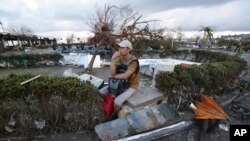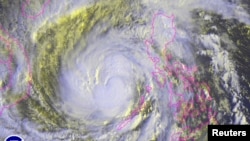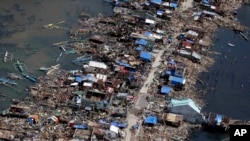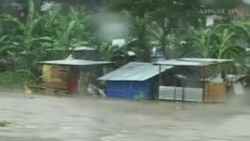MANILA —
The Philippine Red Cross estimates that more than 1,000 people were killed in the coastal city of Tacloban and at least 200 in hard-hit Samar province when the year’s strongest tropical cyclone made landfall Friday morning.
The Philippine government is trying to verify reports of at least 100 dead in a coastal town but gave no details. Government and relief workers are now contending with blocked roads, power outages and spotty communications as they try to reach people in need.
The 315-kilometer-per-hour winds of Super Typhoon Haiyan left a band of destruction across the central part of the country, which is made up of dozens of islands.
From Samar and Leyte provinces on the east to Palawan on the west, relief workers are trying to get through roads blocked by downed trees and power lines, while runways in functioning airports have been cleared for government planes loaded with relief goods and communications equipment.
Officials are focused on Tacloban City on the coast of Leyte, which suffered a storm surge about five meters high that left bodies strewn across the ground.
In a nationally televised situation briefing in Manila, Presidential Cabinet Secretary Rene Almendras told the country’s emergency management council that the government is trying to send as many resources as possible to the hard-hit areas.
“The president called a few local government officials in certain areas, who all promised to help, so [now the problem is] how do we move them? That’s what’s being addressed,” said Almendras.
A Department of Transportation representative says privately owned commercial shipping lines have offered to move goods between the islands.
Major cell phone providers have requested that their workers be moved to the front of the lines of those waiting to fly to airports near the devastation, so they can restore communications.
First responders, including the national police and the Philippine Red Cross, are calling for backup personnel because they say their own workers have been directly affected by Haiyan.
The government ordered a forced evacuation and put relief packs in place well ahead of the storm, and about 800,000 people heeded the call to leave. But now some of those residents from remote areas have nowhere to return to in the wake of Haiyan's destruction.
Maria Reyes in Manila says she made brief contact with a few long-time residents on her family’s property in Buswanga, in northern Palawan Province. She says her second cousin oversees the Palawan property, which includes a resort of native bungalows called "kubo" set on stilts in the bay. "
"She says the resort was almost completely washed away," Reyes said. "There are people living on the shore on the left-hand side of the kubo and they were texting me last night and they said they had no place to go, because if they would go up the mountain, the trees would fall on them. If they stayed on the shore, then the waves would eat them up. Their houses are gone. So I don’t know what happened to them. I still haven’t heard from them.”
Government officials say they are still piecing together assessments of the destruction in the west.
Members of the international community have pledged support.
On Saturday morning, a United Nations official surveyed Tacloban and compared the damage there to the 2004 Indian Ocean tsunami.
The Philippine government is trying to verify reports of at least 100 dead in a coastal town but gave no details. Government and relief workers are now contending with blocked roads, power outages and spotty communications as they try to reach people in need.
The 315-kilometer-per-hour winds of Super Typhoon Haiyan left a band of destruction across the central part of the country, which is made up of dozens of islands.
From Samar and Leyte provinces on the east to Palawan on the west, relief workers are trying to get through roads blocked by downed trees and power lines, while runways in functioning airports have been cleared for government planes loaded with relief goods and communications equipment.
Officials are focused on Tacloban City on the coast of Leyte, which suffered a storm surge about five meters high that left bodies strewn across the ground.
In a nationally televised situation briefing in Manila, Presidential Cabinet Secretary Rene Almendras told the country’s emergency management council that the government is trying to send as many resources as possible to the hard-hit areas.
“The president called a few local government officials in certain areas, who all promised to help, so [now the problem is] how do we move them? That’s what’s being addressed,” said Almendras.
A Department of Transportation representative says privately owned commercial shipping lines have offered to move goods between the islands.
Major cell phone providers have requested that their workers be moved to the front of the lines of those waiting to fly to airports near the devastation, so they can restore communications.
First responders, including the national police and the Philippine Red Cross, are calling for backup personnel because they say their own workers have been directly affected by Haiyan.
The government ordered a forced evacuation and put relief packs in place well ahead of the storm, and about 800,000 people heeded the call to leave. But now some of those residents from remote areas have nowhere to return to in the wake of Haiyan's destruction.
Maria Reyes in Manila says she made brief contact with a few long-time residents on her family’s property in Buswanga, in northern Palawan Province. She says her second cousin oversees the Palawan property, which includes a resort of native bungalows called "kubo" set on stilts in the bay. "
"She says the resort was almost completely washed away," Reyes said. "There are people living on the shore on the left-hand side of the kubo and they were texting me last night and they said they had no place to go, because if they would go up the mountain, the trees would fall on them. If they stayed on the shore, then the waves would eat them up. Their houses are gone. So I don’t know what happened to them. I still haven’t heard from them.”
Government officials say they are still piecing together assessments of the destruction in the west.
Members of the international community have pledged support.
On Saturday morning, a United Nations official surveyed Tacloban and compared the damage there to the 2004 Indian Ocean tsunami.














